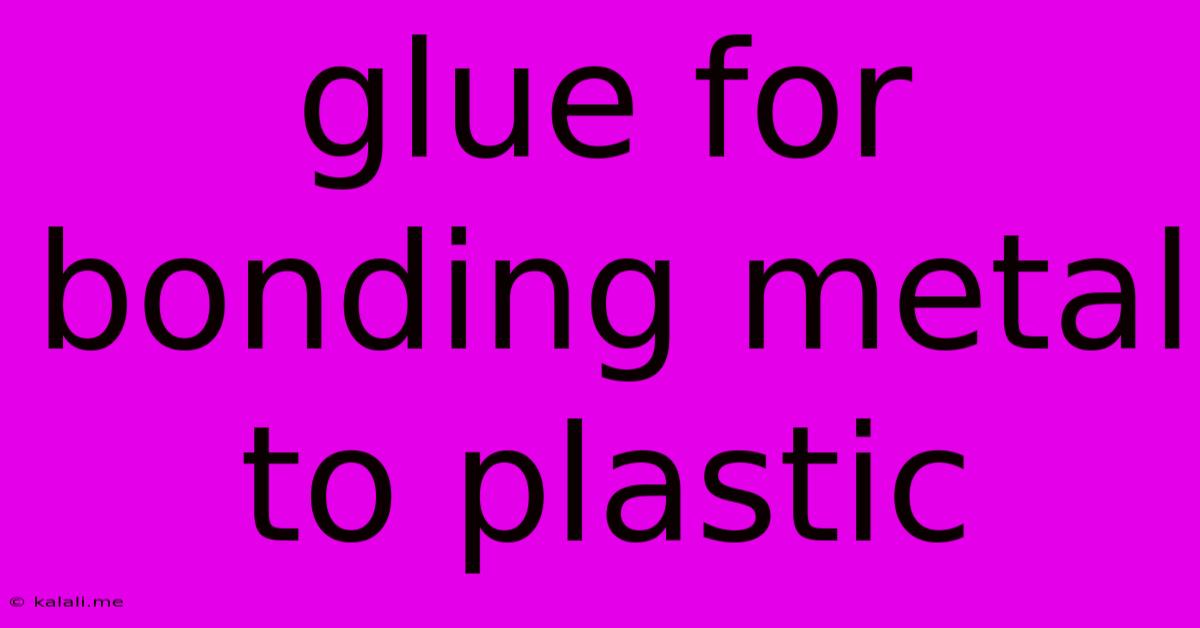Glue For Bonding Metal To Plastic
Kalali
May 22, 2025 · 4 min read

Table of Contents
Choosing the Right Glue for Bonding Metal to Plastic: A Comprehensive Guide
Meta Description: Finding a reliable adhesive for metal-to-plastic bonding can be tricky. This guide explores various adhesive types, their strengths and weaknesses, surface preparation techniques, and application tips for a successful bond. Learn which glue is best for your project!
Bonding metal to plastic presents unique challenges due to the inherent differences in their surface properties. Metals are typically rigid and have high surface energy, while plastics are often more flexible and possess lower surface energy. This means selecting the right adhesive is crucial for a strong, durable, and long-lasting bond. This comprehensive guide will walk you through the different types of adhesives suitable for this application, crucial preparation steps, and application tips to achieve successful metal-to-plastic bonding.
Understanding the Challenges of Metal-to-Plastic Bonding
The difficulty in bonding metal to plastic stems from the disparity in their surface characteristics. Metals, especially those prone to oxidation, can create a barrier that prevents proper adhesion. Plastics, on the other hand, may have a low surface energy, making it harder for the adhesive to wet and spread effectively. This can lead to weak bonds that are susceptible to failure under stress or environmental factors. Therefore, understanding the properties of both materials and selecting the appropriate adhesive is essential for a successful outcome.
Types of Adhesives for Metal-to-Plastic Bonding
Several adhesive types are effective for joining metal and plastic, each with its own advantages and disadvantages:
-
Epoxy Adhesives: These two-part adhesives offer excellent strength and versatility. They are suitable for a wide range of metals and plastics and are resistant to various environmental factors. However, they require precise mixing and have a relatively longer curing time. They are a good choice for applications requiring high strength and durability.
-
Cyanoacrylate (Super Glue): Known for their fast curing time, cyanoacrylates are convenient for quick repairs and smaller projects. However, their bond strength might not be as high as epoxy for heavy-duty applications. Their strength can also vary depending on the specific type of plastic and metal being bonded.
-
Acrylic Adhesives: Acrylic adhesives provide a good balance of strength, flexibility, and ease of use. They often have a longer working time than cyanoacrylates but a shorter cure time than epoxy, making them suitable for many applications. They are often a good option for less demanding projects.
-
Polyurethane Adhesives: These adhesives excel in applications requiring high impact resistance and flexibility. They are often used for bonding dissimilar materials and are known for their durable bonds. They are a strong contender for applications exposed to vibrations or significant stress.
-
Structural Adhesives: This broad category includes high-performance adhesives designed for strong, durable bonds in demanding applications. They frequently require more specialized application techniques and often need specialized primers to enhance adhesion.
Surface Preparation: A Critical Step
Proper surface preparation is paramount for achieving a strong bond between metal and plastic. This typically involves:
- Cleaning: Thoroughly clean both surfaces with a suitable solvent to remove any grease, oil, dirt, or other contaminants. Isopropyl alcohol is a commonly used option.
- Abrasion: Lightly abrade both surfaces using sandpaper or a similar abrasive material to increase surface roughness and improve adhesion. This creates more surface area for the adhesive to grip.
- Priming (Optional): In some cases, using a primer specifically designed for metal-to-plastic bonding can significantly enhance the bond strength and durability, especially with challenging material combinations.
Application Techniques for Optimal Bonding
- Apply Adhesive Evenly: Use a consistent, thin layer of adhesive to ensure proper coverage and prevent excess adhesive from causing problems.
- Clamp or Secure: Once the adhesive is applied, clamp or otherwise secure the parts together until the adhesive fully cures to prevent movement and ensure proper bonding.
- Curing Time: Allow sufficient curing time for the adhesive to reach its full strength. This time will vary depending on the type of adhesive used and environmental conditions. Consult the adhesive manufacturer’s instructions for specific curing times.
Choosing the Right Adhesive for Your Project
The optimal adhesive choice depends on several factors, including the type of metal and plastic being bonded, the strength requirements of the bond, the environmental conditions the bond will be exposed to, and the desired curing time. Consider the specific needs of your project carefully before selecting an adhesive.
By following these guidelines and carefully considering your specific application needs, you can successfully bond metal to plastic and create a durable and reliable joint. Remember to always consult the manufacturer's instructions for specific guidance on using your chosen adhesive.
Latest Posts
Latest Posts
-
Does The Period Go Inside Quotes
May 22, 2025
-
Many Are Called But Few Are Chosen
May 22, 2025
-
How To Drain A Hot Water Heater
May 22, 2025
-
Positive Definite And Positive Semidefinite Matrix
May 22, 2025
-
Arham City How To Get Phones To Ring
May 22, 2025
Related Post
Thank you for visiting our website which covers about Glue For Bonding Metal To Plastic . We hope the information provided has been useful to you. Feel free to contact us if you have any questions or need further assistance. See you next time and don't miss to bookmark.